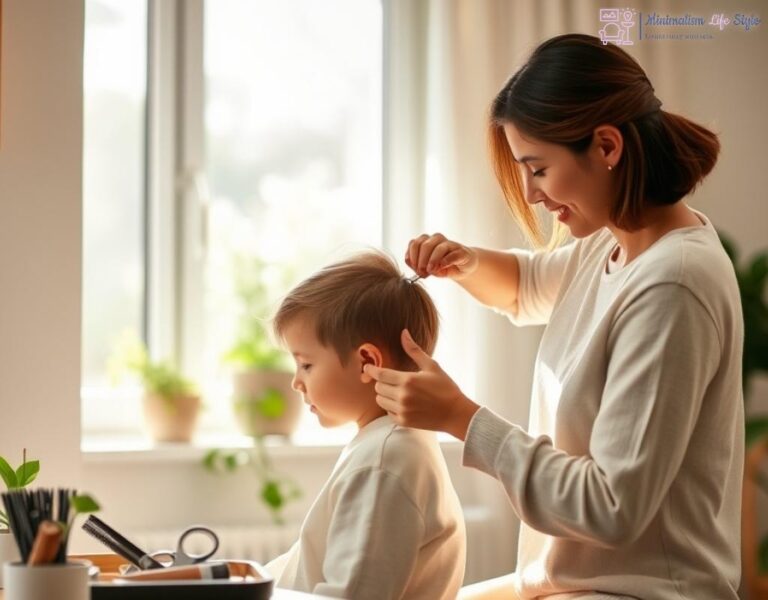Identifying Emotional Clutter: The First Step to Minimalism
Just as physical clutter can overwhelm our living spaces, emotional clutter can suffocate our relationships and mental well-being. Emotional clutter refers to the burdensome feelings, unresolved conflicts, and past grievances that accumulate over time, creating a chaotic internal environment. Recognizing and addressing this clutter is the first step on the path to minimalism in our emotional lives.
Identifying emotional clutter requires a keen awareness of our feelings and behaviors. Often, we may feel a sense of heaviness, anxiety, or frustration without understanding the root cause. By reflecting on our emotional state, we can uncover the hidden baggage that weighs us down. Here’s a list of common signs that indicate emotional clutter:
- Persistent Negative Emotions: Feelings of anger, sadness, or resentment that linger.
- Avoidance Behavior: Shying away from difficult conversations or situations.
- Overthinking: Ruminating on past conflicts or decisions.
- Physical Symptoms: Experiencing stress-related issues like headaches or fatigue.
- Difficulty in Relationships: Frequent misunderstandings or arguments with family members.
Once you’ve identified the emotional clutter, the next step is to actively work towards decluttering. Here are some effective strategies:
- Journaling: Write down your thoughts and feelings to externalize them. This can provide clarity and insight.
- Open Communication: Engage in honest discussions with family members about unresolved issues.
- Mindfulness Practices: Techniques such as meditation can help ground you and create space for emotional healing.
- Seek Professional Help: Sometimes, talking to a therapist can provide the guidance needed to navigate complex emotions.
By systematically identifying and addressing emotional clutter, families can foster healthier relationships and create a supportive environment that encourages growth and understanding.
Tools for Letting Go: Techniques for Family Healing
In the journey of decluttering emotional baggage, embracing vulnerability through open dialogue becomes a powerful tool for healing. When family members express their feelings candidly, it paves the way for understanding and compassion. This approach not only fosters connection but also encourages the release of pent-up emotions that often contribute to conflict. By creating a safe space for each member to share their thoughts, families can dismantle barriers that hinder emotional growth.
Forgiveness is one of the most profound techniques for letting go of emotional baggage. It involves acknowledging the hurt and choosing to release the grip of resentment. This process is not about condoning actions but rather about freeing oneself from the chains of past grievances. When families actively practice forgiveness, they create an atmosphere of healing that allows for renewed relationships. It’s important to note that this journey may require time and patience, as emotional wounds can run deep. However, embracing forgiveness can lead to transformative healing and stronger familial bonds.
In the midst of emotional clutter, cultivating gratitude serves as a beacon of hope. By focusing on the positive aspects of family life, individuals can shift their perspective from what is lacking to what is abundant. This technique not only reduces feelings of resentment but also enhances overall well-being. Families that engage in gratitude practices—such as sharing daily appreciations or reflecting on shared experiences—often find themselves more resilient in the face of conflict. Ultimately, cultivating gratitude can transform the family dynamic, fostering an environment of love and acceptance.
Creating a Peaceful Space: Designing Your Home for Harmony

When we think about our homes, they should reflect not only our physical needs but also our emotional well-being. Designing spaces with intention can significantly influence the emotional atmosphere within the family. For instance, creating open areas encourages communication and connection, while cozy nooks can provide a sense of refuge and personal space. Arranging furniture to facilitate interaction—such as positioning chairs in a circle instead of facing a television—can foster deeper conversations and strengthen relationships.
Additionally, consider the flow of your space. A clutter-free environment allows for a natural progression from one area to another, promoting a sense of calm and ease. Incorporating elements of nature, such as plants or natural light, can enhance feelings of tranquility, making your home a sanctuary where family members feel safe to express themselves.
Beyond mere aesthetics, the emotional resonance of your home plays a crucial role in conflict resolution. Incorporating personal artifacts—like family photos, heirlooms, or artwork created by loved ones—can serve as constant reminders of shared values and connections. These touchpoints act as anchors, helping to cultivate a sense of belonging and unity, especially during challenging times.
Moreover, consider creating a dedicated space for family gatherings or discussions. This could be a simple table adorned with meaningful objects that spark joy and conversation. When family members gather in a designated area that feels warm and inviting, it encourages a spirit of togetherness and openness, enabling more constructive dialogue about emotional issues.
The colors and textures present in your living space can profoundly impact emotional states. Soft, muted tones like blues and greens are known to promote calmness, while warmer colors like yellows and oranges can evoke feelings of happiness and energy. Balancing these hues throughout your home not only creates visual appeal but can also enhance emotional well-being.
Textural elements also play a critical role; soft fabrics, natural materials, and inviting furnishings contribute to a sense of comfort and serenity. A well-designed space that prioritizes harmony can become a refuge for family members, diminishing stress and fostering a more peaceful environment where conflicts can be resolved with compassion and understanding.
Communicating with Clarity: The Role of Open Dialogue
In any family dynamic, the ability to communicate openly is paramount. Open dialogue serves as the bedrock for resolving conflicts, allowing members to express their feelings without fear of judgment. When families prioritize clear communication, they pave the way for a healthier emotional environment where misunderstandings can be addressed before they escalate. This foundation of trust not only encourages honesty but also nurtures a sense of belonging, making it easier for individuals to voice their concerns and emotions.
To maximize the benefits of open dialogue, families can adopt several strategies that enhance clarity in communication. First, it’s essential to practice active listening. This means truly hearing what others are saying rather than merely waiting for your turn to speak. By acknowledging each family member’s perspective, you validate their feelings and create a sense of safety. Moreover, using ‘I’ statements can transform potentially confrontational exchanges into constructive discussions. For instance, saying, ‘I feel hurt when…’ rather than ‘You always make me feel…’ shifts the focus from blame to personal experience, fostering empathy and understanding.
Additionally, setting aside regular time for family discussions can provide a structured approach to communication. These designated moments can serve as a safe space where feelings can be aired, and grievances can be addressed without distractions. Families might find it helpful to create an agenda for these meetings, ensuring everyone has the opportunity to speak on issues that matter to them. This proactive approach minimizes the risk of emotional clutter accumulating over time.
Another crucial aspect of effective communication is emotional literacy—the ability to recognize, understand, and manage emotions. When family members can articulate their feelings clearly and accurately, it reduces the likelihood of miscommunication. Engaging in exercises that promote emotional vocabulary can significantly enhance this skill. For instance, families can explore lists of emotions together, discussing what each term means and when they might experience those feelings.
By integrating emotional literacy into family conversations, members can better navigate complex emotional landscapes. They learn to express not just what they feel but why they feel that way, leading to deeper connections and fewer conflicts. Ultimately, open dialogue is not merely about speaking; it’s about fostering an environment where all voices are heard, respected, and valued. This approach not only declutters emotional baggage but also cultivates a harmonious family life that thrives on understanding and compassion.
Sustaining Change: Building Lasting Family Connections
In the dynamic of family life, establishing a foundation of emotional clarity and connection is essential for long-term harmony. Once the clutter of unresolved conflicts has been addressed and the air cleared, it becomes crucial to focus on sustaining that positive change. Building lasting connections requires intentional efforts, allowing families to thrive amidst challenges while avoiding the pitfalls of emotional baggage.
One of the most effective ways to maintain emotional strength is through the establishment of shared rituals. These rituals can range from weekly family dinners to monthly outings or even simple nightly routines of sharing highlights from the day. Such practices create a predictable framework that fosters connection and strengthens the familial bond. When family members engage in these shared experiences, they cultivate a sense of belonging and unity, which acts as a buffer against potential conflicts.
Moreover, these rituals can be tailored to reflect the unique dynamics of the family. For instance, if a family values creativity, they might organize a monthly art night where everyone contributes. By integrating personal interests into shared activities, families not only keep the connection alive but also enhance emotional intimacy, allowing members to feel valued and understood.
Another vital aspect of sustaining change is fostering emotional intelligence among family members. This involves recognizing and understanding emotions—both one’s own and those of others. By encouraging open discussions about feelings, families can create an environment where emotional literacy thrives. This practice not only aids in resolving conflicts but also prevents misunderstandings from escalating.
Regularly engaging in activities that promote emotional intelligence can be transformative. For instance, families can participate in workshops or activities designed to enhance empathy and communication skills. This not only empowers individuals to express themselves more effectively but also equips them with the tools to navigate complex emotional landscapes. As emotional intelligence grows within the family, so too does the resilience to handle external pressures and internal conflicts, thus solidifying the connection between family members.
Ultimately, the journey of decluttering emotional baggage does not end with initial resolutions; it requires ongoing commitment and effort. By establishing shared rituals and nurturing emotional intelligence, families can create a robust framework that allows them to flourish. These practices not only sustain change but also enrich family life, transforming it into a source of strength and support that endures.




